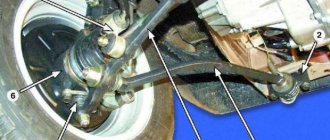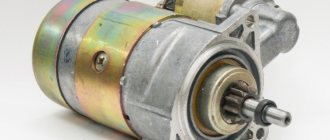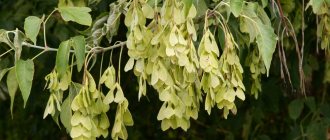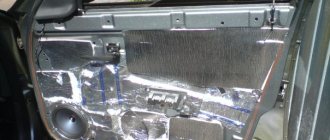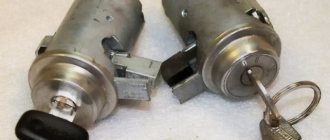American maple is a deciduous tree that came to us from North America. The main feature of this plant is its ability to grow in all directions. It is for this reason that maple is cultivated for the quick landscaping of squares and parks. However, the appearance of this tree in the garden will be an unpleasant surprise for the summer resident, since getting rid of maple is not so easy. The fact is that the American maple variety, unlike the Canadian one, grows quite aggressively. Growing in one place, it captures new territories. Let's look at how you can quickly and effectively free your area from this weed tree.
Plant characteristics
The light-loving maple originated from North America. There it is widespread, grows up to 20 meters or more in height and can live up to a hundred years. In street plantings, trees live shorter lives, up to 30 years. The tree has a short trunk, branched at the base, with dark bark and cracks, which turn into deep grooves as the tree ages.
The crown of the tree is spreading, the leaves have jagged edges and a dark upper surface. In autumn the leaves turn yellow and reddish foliage may appear. Because of the leaves similar to those of an ash tree, this type of maple is also called Ash-like. The winged fruits ripen at the end of summer and remain on the branches until spring. The tree tolerates frosts of 35 and 40 degrees well, so it feels good even in the Urals and Siberia.
Source: Depositphotos
The characteristically shaped leaves and winged maple fruits are recognizable
Video
Experienced gardeners and gardeners share their opinions on ways to combat the American maple and the need to eradicate it in the following videos:
His main specialty is an accountant, so even at his dacha he strives for accuracy and achieving ideal order in everything. Preference is given to growing grapes. I am sure that the deeper you delve into gardening and gardening, the more you understand that there is no limit to perfection!
Found a mistake? Select the text with the mouse and click:
Oklahoma farmer Carl Burns developed an unusual variety of multi-colored corn called Rainbow Corn. The grains on each cob are of different colors and shades: brown, pink, purple, blue, green, etc. This result was achieved through many years of selecting the most colored ordinary varieties and crossing them.
Natural toxins are found in many plants; Those grown in gardens and vegetable gardens are no exception. Thus, the seeds of apples, apricots, and peaches contain hydrocyanic acid, and the tops and peels of unripe nightshades (potatoes, eggplants, tomatoes) contain solanine. But do not be afraid: their number is too small.
The homeland of pepper is America, but the main breeding work on developing sweet varieties was carried out, in particular, by Ferenc Horvath (Hungary) in the 20s. XX century in Europe, mainly in the Balkans. Pepper came to Russia from Bulgaria, which is why it received its usual name - “Bulgarian”.
Convenient Android applications have been developed to help gardeners and gardeners. First of all, these are sowing (lunar, flower, etc.) calendars, thematic magazines, and collections of useful tips. With their help, you can choose a day favorable for planting each type of plant, determine the timing of their ripening and harvest on time.
One of the most convenient methods for preparing a harvest of vegetables, fruits and berries is freezing. Some believe that freezing causes the nutritional and health benefits of plant foods to be lost. As a result of the research, scientists have found that there is practically no decrease in nutritional value when frozen.
You need to collect medicinal flowers and inflorescences at the very beginning of the flowering period, when the content of nutrients in them is highest. Flowers are supposed to be picked by hand, tearing off the rough stalks. Dry the collected flowers and herbs, scattered in a thin layer, in a cool room at natural temperature without access to direct sunlight.
“Frost-resistant” varieties of garden strawberries (more often simply “strawberries”) need shelter just as much as ordinary varieties (especially in those regions where there are snowless winters or frosts alternating with thaws). All strawberries have superficial roots. This means that without shelter they freeze to death. Sellers’ assurances that strawberries are “frost-resistant,” “winter-hardy,” “tolerates frosts down to −35 ℃,” etc. are deception. Gardeners must remember that no one has yet managed to change the root system of strawberries.
A new product from American developers is the Tertill robot, which weeds weeds in the garden. The device was invented under the leadership of John Downes (creator of the robot vacuum cleaner) and works autonomously in all weather conditions, moving over uneven surfaces on wheels. At the same time, it cuts off all plants below 3 cm with the built-in trimmer.
From varietal tomatoes you can get “your own” seeds for sowing next year (if you really like the variety). But it is useless to do this with hybrids: you will get seeds, but they will carry the hereditary material not of the plant from which they were taken, but of its numerous “ancestors”.
Gardeners often approach the selection of seedlings extremely responsibly, trying to plan planting with maximum precision to obtain maximum benefit from the plants. They take into account not only the climatic conditions in their region, but also lighting and soil characteristics. However, sometimes owners of suburban areas are interested in what to water the tree with so that it dries out quickly. This method, of course, can hardly be considered humane, but sometimes there is simply no other way out.
For example, if there is an old tree on the site with a trunk diameter of more than 30 cm, but it cannot be cut down because there are other structures or plants nearby. The only way out in this situation is to dry the tree using special chemicals.
How to water a tree to make it dry quickly
Why does the American maple need to be destroyed?
Wood is a strong allergen with a wide distribution area. In addition to rapid spread, it has a number of disadvantages:
- It grows quickly and crowds out other plantings. At the same time, it is not the best neighbor for residential buildings - the branches and trunk are quite fragile and can fall on the roof in a strong wind. Fragile branches and trunks can fall on your home or other plantings at any time.
- During flowering, it releases a large amount of pollen, which can cause allergies in people.
- The crown grows very widely and is difficult to correct. The plant is not suitable for landscape design. The wide crown also shades other plantings.
- The root system and shoots spread quickly and widely, breaking the asphalt and preventing other plants from growing.
- Roots and decaying leaves release toxins that inhibit the growth of other plants.
- The wood is brittle and therefore not suitable for construction. Only wooden boxes or household items are made from American maple wood: vases, sculptures, knife handles.
The tree has its positive aspects, but they are more suitable for its growth in the wild. Spreading crowns often attract residents. Birds build nests on the branches and eat the fruits of the tree. Lionfish and squirrels love to eat. Scientists use maple to breed new varieties of wood. For example, as a result of selection, the decorative maple Flamingo appeared.
If you do not want to destroy the tree and still decide to leave the maple on the site, it will not require special care. In the spring it can be fed with potassium and sodium fertilizers and watered periodically. The watering rate is 15 liters for old trees and twice as much for young trees. In summer, it is advisable to weed and loosen the soil around the tree and remove side branches.
We still recommend destroying the surrounding shoots like weeds, if you do not plan to propagate maples over the entire area of the site.
Source: Depositphotos
Maple seeds take root well in the soil, many of them germinate
Methods for removing trees from a site
How did the American maple appear in Europe?
In the middle of the 16th century, the seeds of the American (ash-leaved) maple were accidentally brought to Spain. Nobody paid attention to them, since local maple species had similar lionfish. But the light fliers were caught by the wind and scattered along the coast.
Over the course of a couple of centuries, the range of this plant has increased many times over. It was even used for landscaping cities. An unpretentious tree has no pests that can harm it. Therefore, the American maple is a weed that is ready to conquer any area where its seeds reach.
Already in the middle of the 18th century, the French press reported that trees coming from Spain were harming winegrowers in France. Methods for destroying maple trees were published there. For almost thirty years, periodicals have returned to the problems of eliminating this plant.
The recommendations were published in a brochure by Charles de Beauchet, “Comment éliminer l'érable sur un vignoble”, which was distributed in the provinces where the grapes were grown.
Interesting excerpts from this book are still relevant today: “...You need to fight the American maple as soon as the shoots appear.
An annual sprout that is uprooted can be easily and permanently removed. But if sufficiently powerful roots have formed and a trunk has formed instead of a stem, then a serious struggle with this tree awaits.
When cutting down, several new trunks are formed within a short time, now a more powerful plant is formed from the root. It’s much more difficult to fight it...” (literary translation from French by the author of the article).
How to remove maple from a site
The work does not begin on your own site. We need to find trees that spread the flies. If they remain nearby, then every year thousands of flying seeds will be brought into the garden. A certain part will be in favorable conditions, the seed will begin to grow, and by autumn another sprout will grow.
Of course, it is difficult to cut down a tree. Many defenders will certainly come to its defense, but you can convince and show the harm from such a plant. Instead, it is better to plant a linden, ash or other tree that will quickly grow in place of the maple. There will be much more benefits.
How to get rid of American maple
One of the methods of dealing with maple is prevention. The plant easily takes root in empty areas where the wind can blow lionfish, so plant the entire area with useful plants. If you have desert areas, check them regularly and eliminate any strange weeds or growths.
Dealing with weeds and small trees is, of course, easier than with plantings that take up half the garden. So if the trees are small, you can try simple gentle methods first:
- Apply salt to the cut piece of wood. The layer must be thick - salt inhibits the growth of the tree and inhibits the root system. Cover the cut with plastic to ensure a seal. You can cover the cut with light-proof material. The method does not harm other trees or soil.
- Bury the tree stump with plenty of crushed stone or soil. If possible, concrete the area.
- Remove the rhizome and above-ground parts of the tree from the ground. If the root is deep, it may be worth using agricultural machinery. (Read about how to remove tree stumps on your property here).
Popular drugs and their uses
Here is a list of the most popular reagents that are used to destroy stumps and root systems of trees:
- saltpeter and urea;
- copper or iron sulfate;
- salt.
Saltpeter and urea
These reagents (potassium and ammonium nitrate, as well as urea) are used where it is possible to burn the stump after treatment.
After all, they do not destroy the wood, but sharply increase its flammability , which is why even the roots burst into flames from a small fire.
To introduce them, holes with a diameter of 10–50 mm are drilled; the location of the holes depends on the method of tree removal.
On sawn stumps, drill vertically, evenly distributing holes along the cut; on broken stumps, drill the trunk, placing holes around the entire perimeter.
The distances between the holes are 5-10 cm . If the barrel is drilled from the outside, then the drill is directed at an angle of 20–40 degrees so that the reagent does not spill out.
Any type of saltpeter or urea is poured into the prepared holes (no need to mix them together) to the top, then watered a little so that the granules settle, and the holes are closed with a wooden, clay or plasticine stopper.
A wooden plug is made from a thick branch with a knife so that it fits 1–2 mm into the hole with noticeable force. Then it is inserted into the hole filled with the reagent and hammered in with a hammer so that it sinks 1–2 cm. The protruding remains of branches are not cut off so as not to loosen the plug.
A clay plug can be made from clay or the surface layer of the earth; for this, the soil is crushed and a little water is added.
The amount of water is determined experimentally - after thorough mixing, the consistency of the clay should be similar to a very thick dough or not very hard plasticine.
Clay is placed in the hole until it is filled and compacted with a finger, gradually adding more. Plasticine cork is made in the same way, only plasticine is used instead of clay.
After 1–2 years, the roots are dug up and a small fire is laid around the trunk .
If you don’t know how to dig up roots, we recommend reading the article Manual uprooting.
Then the fire is set on fire and care is taken to ensure that the fire from the burning stump does not spread to neighboring trees, buildings or grass.
While the stump soaked in reagents is “ripening,” the soil around it is filled with nitrogen-containing substances , so it is advisable to plant any fruit plants at a distance of 4–5 meters from it. This distance is enough to reduce the amount of nitrates to a safe level.
After burning the stump, the hole is filled with old and new soil, then inedible plants are planted, producing a large volume of green mass. In the fall, all greens collected from the plant must be burned in order to completely utilize nitrogen compounds unsuitable for plants and people.
Next year the site is ready to accept any plants. If construction work is planned at this place, then it can begin immediately after the pit has cooled.
This method is ineffective against diseases of plants with a widely branched root system , because the reagents will not harm pathogens located noticeably below the combustion zone. In addition, it cannot be used on peaty soils, because a burning stump will set the peat on fire, and an underground fire will start, which is very difficult to extinguish.
Copper or iron sulfate
Both substances are very toxic and kill any bacteria living in wood, so they are used to disinfect the roots of diseased trees. The preparations are applied in the same way as saltpeter, only the holes are made with a diameter of 5–8 mm and a depth of 5–10 cm.
Suppression of the vital activity of the root begins within a few days, but complete death of the wood occurs after 1–2 years. After the wood dies, the roots must be dug up and uprooted in any way or, surrounded with firewood, burned.
These reagents
cannot be used near metal pipes , as they will dramatically intensify all corrosion processes.
In addition, within a radius of 3–5 meters, the content of these substances will increase, which will negatively affect the vital activity of microorganisms involved in soil restoration, so any plants will grow poorly there for several years .
If the roots were not removed but burned, then this period will increase to tens of years. If the roots are uprooted, then after 2-3 years the level of these substances will decrease, after which the soil will gradually recover.
Salt
In 1–2 months, this reagent that live in them. They are added in the same way as both types of vitriol.
If the area around the tree is planned to be used as a road or concrete-filled area, then after it dies, the stump and roots can be burned. In all other cases, they need to be uprooted, otherwise excess salt will make the soil infertile for decades, and any iron product will quickly rust.
How to defeat young shoots
If young growth of American maple has appeared on the territory, and you are not a supporter of the use of chemicals, you can use mulching. Soft types of mulch will not help in this case - you must use bark or sawdust, and the mulch must be at least 5 cm thick.
A good result can be obtained by covering the ground with a covering material - spunbond, lutrasil or any dark-colored geotextile will do. Ordinary cardboard will do the job well. Cover the ground and reinforce the covering around the perimeter, as well as in several places in the center, and leave for at least a month. This method is best used after harvest or in the fall. But here it is necessary to take into account that in addition to the maple, other plants will also die, so if it is, for example, a lawn, then it will have to be re-sowed.
Good results can be obtained by using EM drugs, for example, “Shine-3”. Sprinkle the area with overgrown growth with the preparation, carefully reading the instructions. Cover this area with covering material. Be careful with nearby plantings; if they come into contact with them or the soil next to them, the plants may die. The drug is harmless to the environment; moreover, after the period of its influence ends, you will receive a wonderful area ready for planting any plants.
Maples have a large crown that can shade most of the area
How to destroy maple trees in a garden plot?
Maples don't just produce shoots, they produce impenetrable thickets. And the root system is just as impenetrable. We'll have to spray defoliants like the Americans did over Vietnam. Our cherries were the same. An old neglected garden that grew on its own. We hired a small tractor with a small bucket. Although the bucket is small, the tractor itself is strong. The trees weren't even cut down. With this bucket the tractor pulled them out together with the roots. Then we waited about a month for everything to dry. Otherwise, there would not be enough strength to remove it all. There are also large tractors that have a linkage called a fang. This fang is a special device for uprooting. Of course, the tractor is huge, but we’re already tired of the maples. If everything is so boring and beyond the control of your arms and back, then it makes sense to turn around the entire garden once, but remove everything unnecessary. However, the shoots will appear for another season, but so little that even spraying will not be necessary. We simply plowed this area twice, in spring and autumn. And they got rid of the cherries. I found photos online of approximately the equipment that helped us.
This tractor is for very heavy work.
Discussion in our VKontakte group:
Larisa Garina:
I planted maples on purpose, because everyone has their own problems
Anastasia Plakhova:
why destroy them? This is great compost!
Lyudmila Gracheva:
How to destroy cherry shoots?
Galya Tikhonova:
Lyudmila, we are talking about another maple, the Irish maple (I think that’s its real name), also called the American maple, it grows so much that “dear mother.” First of all, you need to get rid of the female trees so that propagation by seeds stops, and the male ones can be left for shade. After cutting, all that remains is to destroy the stumps, there are many different ways: drill a hole, put something in there (I don’t remember what), cover it with a bag for a year, and after a year set it on fire, the stump burns out along with the roots, you can also uproot it, but this problematic, but you can also try herbicides, but you need to spray them on the green leaves.
Natalia Stankevich:
Galya, sprinkle table salt.
Svetlana Heino:
Galya, that's how it is.
You can participate in the discussion by going to the page in our VKontakte group.
Source


